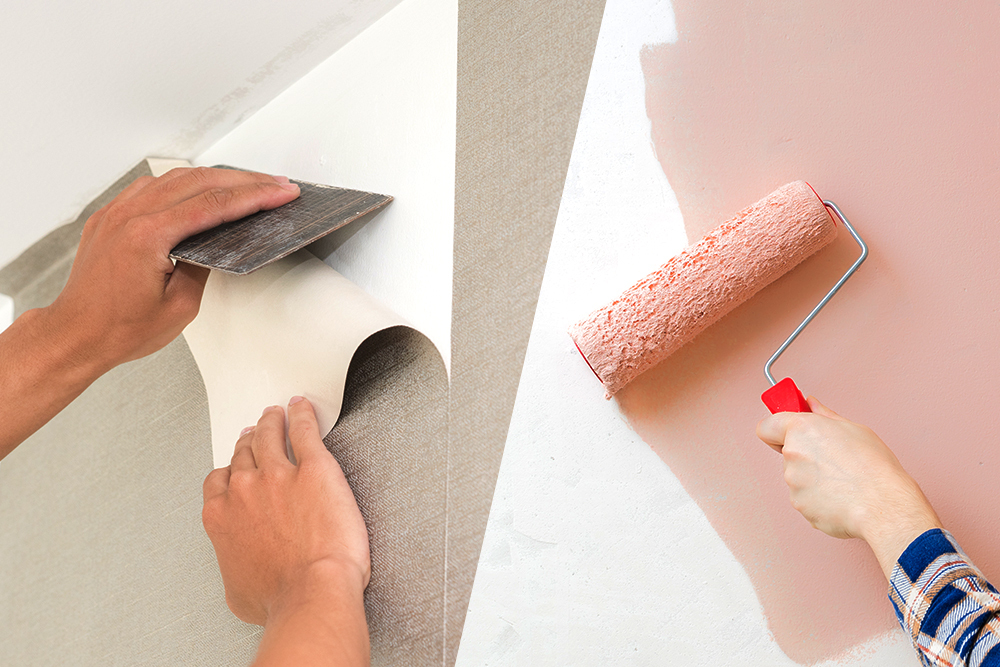
When it comes to transforming the look of your home, the age-old debate between painting and wallpapering often arises. Each option presents its own set of advantages and drawbacks, making it essential to weigh your choices carefully. Whether you are a homeowner looking to refresh your space or a renter contemplating a temporary change, understanding the nuances of these two methods can guide you towards the best decision for your needs.
Understanding the Basics
Definition of Painting
Painting involves applying a liquid pigment to walls using brushes, rollers, or sprayers. This technique can produce a solid colour finish, offering a clean and modern look to any space. The versatility of paint allows for a myriad of colours and finishes, enabling homeowners to express their personal style.
Definition of Wallpapering
Wallpapering, on the other hand, entails adhering decorative paper to walls. This method can introduce intricate patterns, textures, and designs that paint simply cannot replicate. Wallpaper can range from classic floral prints to contemporary geometric patterns, providing a unique aesthetic appeal.
Cost Considerations
Initial Costs of Painting
When assessing the financial aspect, painting generally emerges as the more budget-friendly option. A gallon of quality paint typically costs between £30 to £60, and a DIY project can significantly reduce labour costs. For larger areas, the expense can accumulate, but it remains lower compared to wallpapering.
Initial Costs of Wallpapering
In contrast, wallpaper can be considerably pricier upfront. Rolls of wallpaper can range from £25 to £50 each, and the cost of professional installation can add another £7 per square foot. While wallpapering may involve a higher initial investment, it is often seen as a long-term solution due to its durability.
Long-Term Value
Durability of Paint
Painted walls can last between three and five years before needing a refresh, especially in high-traffic areas. The longevity of paint can be influenced by factors such as the quality of the paint used and the level of maintenance. Regular touch-ups may be necessary to keep the walls looking fresh.
Durability of Wallpaper
Wallpaper, particularly high-quality vinyl options, can last between 10 and 20 years. It is generally more resistant to wear and tear, making it suitable for areas that experience a lot of activity. However, if damaged, replacing a section of wallpaper can be more complicated than simply touching up paint.
Aesthetic Appeal
Visual Impact of Paint
Paint offers a clean and modern aesthetic, which can be easily altered with changing trends. It allows for a broad spectrum of colour choices and finishes, from matte to glossy. However, while paint can provide a uniform look, it may lack the depth and character that wallpaper can offer.
Visual Impact of Wallpaper
Wallpaper can dramatically alter the atmosphere of a room. The variety of patterns and textures available allows homeowners to create a unique focal point or accent wall. The intricate designs of wallpaper can add character and charm, making it a popular choice for those looking to make a bold statement.
Installation Process
Ease of Painting
Painting is often perceived as a straightforward DIY project. With basic preparation, such as cleaning and priming the walls, homeowners can achieve satisfactory results relatively quickly. The application process can usually be completed within a day or two, depending on the size of the area being painted.
Complexity of Wallpapering
Wallpapering requires more meticulous preparation and skill. The walls must be properly primed, and the wallpaper needs to be measured and cut accurately to avoid mismatched patterns. While some modern peel-and-stick options are available, traditional wallpapering can be time-consuming and may necessitate professional installation.
Maintenance Requirements
Upkeep for Painted Walls
Maintaining painted walls involves regular cleaning to prevent the accumulation of dirt and grime. High-quality paints can be wiped down easily, but painted surfaces in high-traffic areas may require more frequent touch-ups to address chips and scuffs.
Upkeep for Wallpapered Walls
Wallpaper is generally easier to clean, particularly vinyl options that can withstand soap and water. However, care must be taken to avoid damaging the paper. If a section of wallpaper becomes stained or damaged, replacing it can be a more labour-intensive process compared to painting.
Lifestyle Considerations
Families and High Traffic Areas
For families with children or pets, painted walls may be more practical. The ease of touch-ups and the ability to change colours frequently can cater to evolving tastes and lifestyles. Paint can adapt to the changing dynamics of a household, making it a flexible choice.
Hosting and Formal Spaces
On the other hand, wallpaper can elevate the sophistication of a space, making it ideal for formal settings or entertaining areas. The rich textures and patterns can create an inviting atmosphere, signalling a commitment to design and detail.
Environmental Impact
Eco-Friendliness of Paint
Many modern paints are available in low-VOC (volatile organic compounds) formulations, making them a more environmentally conscious choice. These paints reduce the release of harmful chemicals into the air, contributing to better indoor air quality.
Eco-Friendliness of Wallpaper
Wallpaper can also be eco-friendly, especially those made from sustainable materials. However, the adhesives used in wallpapering can sometimes contain harmful chemicals, so it is essential to choose products wisely.
Resale Value Considerations
Impact of Paint on Home Value
Freshly painted walls can enhance the appeal of a property, making it more attractive to potential buyers. Neutral colours often resonate well with a broad audience, providing a blank canvas for new homeowners.
Impact of Wallpaper on Home Value
While wallpaper can add character, it may not appeal to all buyers. Some individuals may view wallpaper as outdated or too personal, which could impact resale value. Choosing timeless patterns may mitigate this risk, but it remains a consideration for sellers.
Conclusion: Making the Right Choice
Ultimately, the decision between painting and wallpapering depends on your personal preferences, budget, and lifestyle. If you value versatility, affordability, and ease of maintenance, painting may be the best option for you. Conversely, if you seek durability, texture, and a unique aesthetic, wallpaper might be the better choice.
Consider the factors that matter most to you, and don’t hesitate to combine both methods for a balanced approach. For instance, wallpaper could be used as an accent in one room while painting the rest of your home, allowing you to enjoy the benefits of both styles.
In the end, whether you choose to paint or wallpaper, ensure that you invest in quality materials and take the time to prepare your surfaces properly for the best results. With careful consideration and planning, your walls can become a true reflection of your style and personality.
This article is a comprehensive exploration of the pros and cons of painting versus wallpapering, aimed at helping readers make informed decisions about their home decor.
If you’re living in London and you need reliable painting and decorating service, I would like to invite you to TM Decorating from North London.






